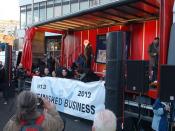A common definition of a labor union is that it is an association of workers who bargain collectively with their employer regarding the terms and conditions of employment. Analysis of Labor Unions on the economy can fall roughly into four relatively large categories, 1) Unions as Maximizing Agents 2) Dispute Resolution: Strikes and Arbitration 3) The Effect of Unions on Wages 4) The Determination of Union Membership.
The general approach to modeling union behavior is to assume that the union's goal is to maximize a well defined utility function of wages and employment. The union is assumed to maximize this objective function subject to constraints imposed by the employer. The economic efficiency between the employer and the union requires that employment be set at the level where the value of marginal product of labor equals the opportunity cost of an hour for workers. The union and employer agree on a wage and employment levels that depend only on the opportunity wage of labor and labor's value of marginal product.
Negotiation is common in many settings. A common feature of all negotiation is an understanding by the parties to the negotiation about the process that will be used to resolve a dispute in the event the parties fail to reach an agreement. Disputes between labor unions and employers can end in a strike or can be resolved by arbitration. Disagreement over contracts or tort damages can result in civil litigation and a decision by a judge or jury. Disagreement between nations can result in military disputes. The dispute settlement process defines the expectations that the parties have about what will happen in the event that no agreement is reached. And this process, in turn, determines negotiator behavior. There are two fundamental types of dispute settlement mechanisms. The first is the systematic...


